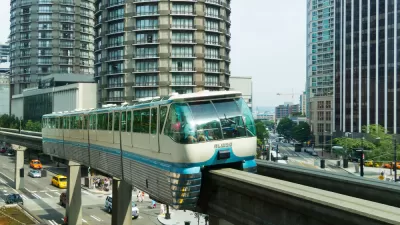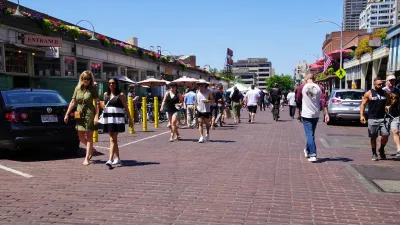Seattle’s new professional hockey team is drawing legions of enthusiastic fans. Around a quarter of them are taking public transit, such as the city’s often-maligned monorail, to games.

It’s not just Taylor Swift who can move people to take transit. Among all the doom and gloom public transit stories, there’s a ray of hope, according to an article by David Kroman in The Seattle Times: the Seattle Center Monorail (cue The Simpsons ‘Monorail’ song, for those of us of a certain age).
The elevated train — built for the 1962 World’s Fair and occasionally mocked in popular culture — saw better ridership in the first quarter of this year than it has in any similar period since at least 2009, easily outpacing its pre-pandemic ridership.
The Monorail’s high ridership can be traced to the success of Seattle’s brand new NHL hockey team, the Kraken, whose arena gave the Monorail a new ridership base. “ Through April, the monorail had 533,000 rides, about 150,000 more than the same period in 2022 and over 100,000 more than the same four months in 2019.”
Public transit was a key component of NHL Seattle’s strategy for limiting traffic congestion to the new stadium. “With each Kraken and Storm ticket, fans would receive a free pass on Sound Transit, Metro and/or the monorail, a benefit not available when the Sonics were still in town. This year, the arena added the perk to concerts and other events.”
Data from the team and transit agencies show that roughly 25 percent of fans are using transit to get to Kraken games, with a smaller percentage of people using transit for other events such as concerts.
FULL STORY: Seattle monorail rides the Kraken wave to higher ridership

Study: Maui’s Plan to Convert Vacation Rentals to Long-Term Housing Could Cause Nearly $1 Billion Economic Loss
The plan would reduce visitor accommodation by 25,% resulting in 1,900 jobs lost.

North Texas Transit Leaders Tout Benefits of TOD for Growing Region
At a summit focused on transit-oriented development, policymakers discussed how North Texas’ expanded light rail system can serve as a tool for economic growth.

Why Should We Subsidize Public Transportation?
Many public transit agencies face financial stress due to rising costs, declining fare revenue, and declining subsidies. Transit advocates must provide a strong business case for increasing public transit funding.

How to Make US Trains Faster
Changes to boarding platforms and a switch to electric trains could improve U.S. passenger rail service without the added cost of high-speed rail.

Columbia’s Revitalized ‘Loop’ Is a Hub for Local Entrepreneurs
A focus on small businesses is helping a commercial corridor in Columbia, Missouri thrive.

Invasive Insect Threatens Minnesota’s Ash Forests
The Emerald Ash Borer is a rapidly spreading invasive pest threatening Minnesota’s ash trees, and homeowners are encouraged to plant diverse replacement species, avoid moving ash firewood, and monitor for signs of infestation.
Urban Design for Planners 1: Software Tools
This six-course series explores essential urban design concepts using open source software and equips planners with the tools they need to participate fully in the urban design process.
Planning for Universal Design
Learn the tools for implementing Universal Design in planning regulations.
Ascent Environmental
Borough of Carlisle
Institute for Housing and Urban Development Studies (IHS)
City of Grandview
Harvard GSD Executive Education
Toledo-Lucas County Plan Commissions
Salt Lake City
NYU Wagner Graduate School of Public Service




























